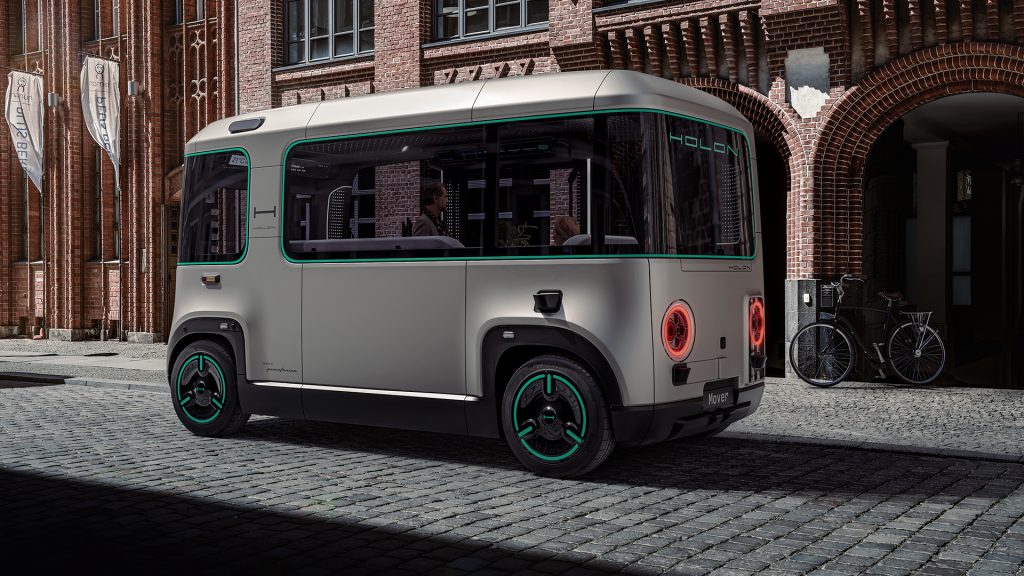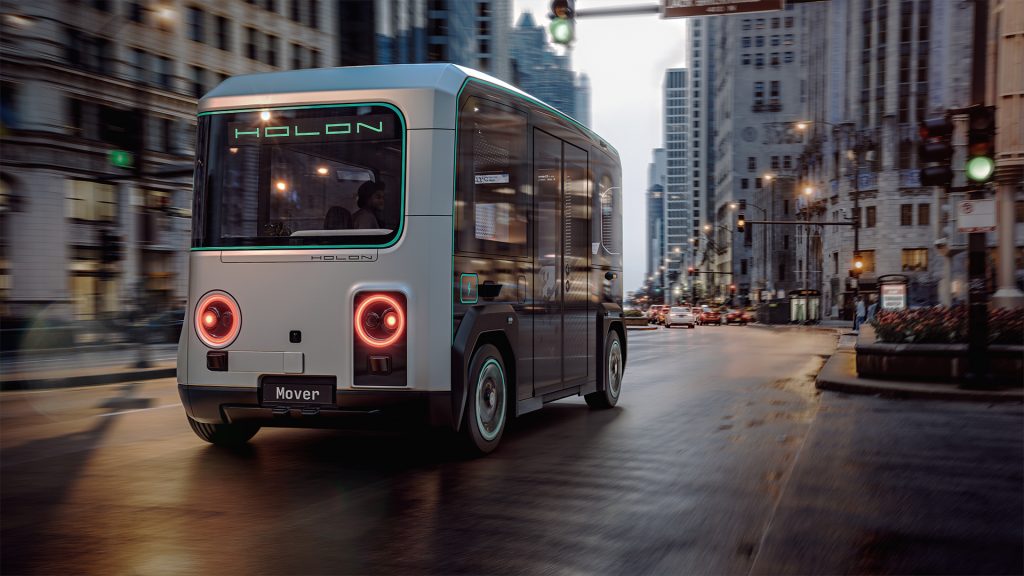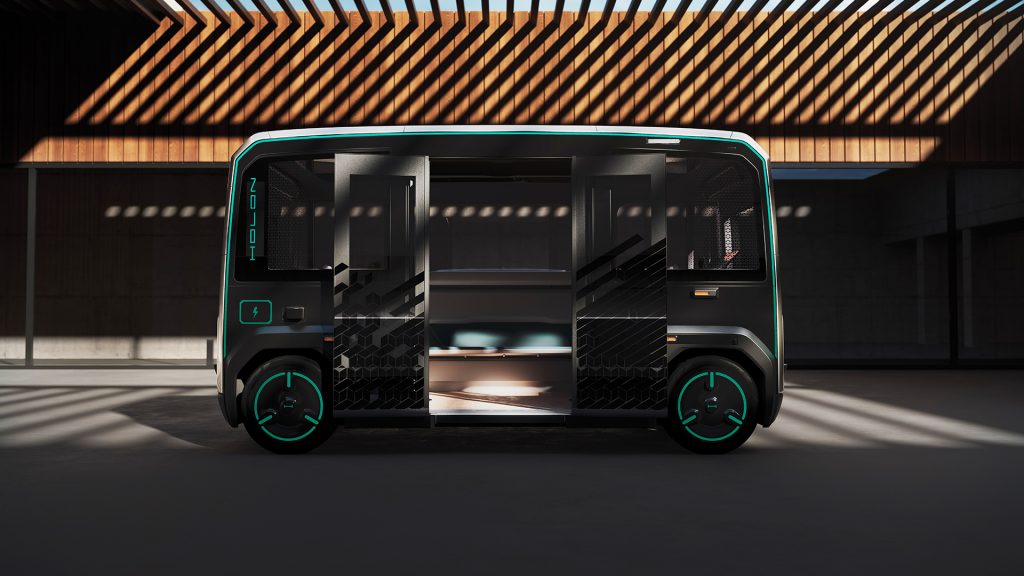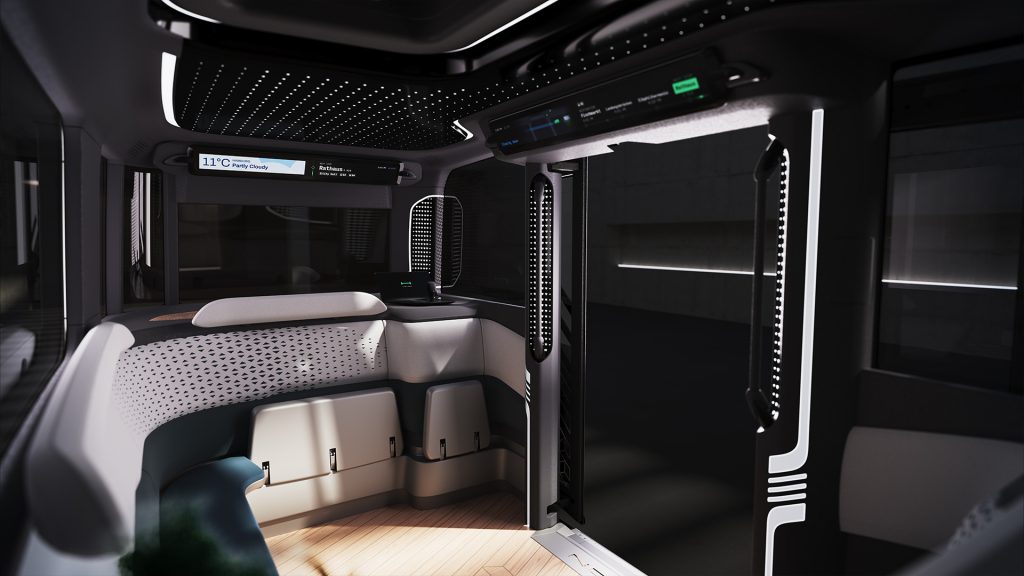
Holon, the new brand from the Benteler Group, debuted its autonomous, electric, and “inclusive” mover at CES 2023. The company claims it’s the world’s first autonomous mover built to automotive standards, leading in safety, ride comfort, and production quality.
“Our mover is an answer to social megatrends: urbanization, climate change, demographics; mobility needs to change,” said Marco Kollmeier, Managing Director of Holon. “With our mover, we are proving that emission-free, safe, comfortable, and inclusive passenger transportation is possible—and thus provides the answer to traffic problems that are becoming prevalent in cities.”
The Holon mover operates autonomously and with a maximum speed of 60 km/h (37 mph). It has a range of about 290 km (180 mi).
“Our mover is specifically designed for autonomous driving,” said Kollmeier. “This is reflected in every step of the development and every detail. The result is the world’s highest-quality vehicle of its kind. As such, we are creating a new dimension of smart, sustainable mobility that ideally complements public and private passenger transport.”
Sustainability is an integral part of the Holon brand, so the mover is electrically driven. Throughout the development, emphasis has been placed on the use of sustainable materials. Over-the-air updates ensure that the vehicle is always kept up to date without the need for service visits.
Areas of application for the mover are on-demand services of not only ride-sharing and ride-hailing but also normal scheduled services. The first pilot project has already been announced in Germany with Hamburg’s Hochbahn, the country’s second-largest mass transit company.
Key Holon applications and customers include private institutions such as campuses, airports, and national parks.

Design by Pininfarina
The vehicle’s eye-catching asymmetrical design by renowned Italian design company Pininfarina is meant to combine maximum functionality with a high recognition value. Its generous spatial concept is intended for up to 15 passengers to fill the gap between personal and public transport concepts. The comfortable, subtly offset seating arrangement provides a sense of privacy while meeting all safety requirements.
“The vehicle design combines two character traits—friendly and inviting as well as technologically advanced and clear,” explained Silvio Pietro Angori, CEO of Pininfarina. “That goes for both the exterior and interior. It immediately makes the Holon mover a design icon. Every detail of the vehicle is designed to make passengers feel more comfortable and safer than in any other mode of transportation.”
Holon is pursuing the goal of allowing everyone to benefit equally from the freedoms offered by mobility, so the mover is designed from the ground up to be inclusive. Electric double-wing doors with photo-electric sensors and an automatically extending ramp with a lowering function are included as standard for barrier-free access. The automatic securing of wheelchairs inside the vehicle combines comfort with safety. Information in Braille and an audiovisual guide provide additional support for visually impaired people during the journey.

Mobileye Drive for SAE Level 4 AD
The mover’s SAE Level 4 automated driving system, using sensor technologies such as lidar, radar, and camera systems, is based on Mobileye Drive, which Founder and CEO Prof. Amnon Shashua mentioned in his update at CES 2023. By focusing on solutions that can be built affordably and work globally for different types of vehicles, the company sees a clear and financially sustainable path to developing both consumer-owned and fleet-deployed AVs.
“Our autonomous driving system is designed to make ground-breaking mobility concepts possible—like the Holon mover,” said Johann Jungwirth, Senior Vice President, Autonomous Vehicles at Mobileye. “Seeing the mover come to life is proof of the robustness and scalability of our approach.”
The scalability of the mover is ensured by three features that help the vehicle make the right decisions on the road. The combination of technologies—an advanced sensing system makes use of redundant sensors, an innovative mapping technology, and a formal model for driving policy—makes the mover an industry-leading mobility concept, according to Holon.
The mover is the latest in a string of implementations for the Mobileye Drive self-driving solution for commercial vehicles. The solution incorporates multiple types of sensors, with its camera subsystem operating independently of its radar/lidar subsystem to deliver True Redundancy. It also uses Mobileye Roadbook, the company’s AV map generated and continually updated by its Road Experience Management crowdsourced mapping technology. It operates under our lean driving policy based on the Responsibility-Sensitive Safety model. And the whole system runs on our EyeQ system-on-chip.
“The market needs vehicles that seamlessly work in any traffic environment—and that is exactly what Holon and Mobileye plan to deliver,” added Jungwirth. “There are communities around the world that are searching for a mobility solution just like it.”
The Holon mover joins a list of applications for Mobileye Drive previously unveiled including the company’s robotaxi, Udelv Transporter, Lohr i-Cristal, and the self-driving shuttle platform from Schaeffler.

E/E and connected car by Cognizant
Besides Pininfarina and Mobileye, another vehicle development partner is the electronics and IT specialist Cognizant Mobility. The company helped Holon throughout the design and architecture development of the mover in the areas of electrics/electronics and connected cars. It provided what is required for a future-oriented E/E architecture including ISO 26262 functional safety, cybersecurity, diagnostics, connectivity, SOTIF (safety of the intended functionality), and the Ethernet network design.
A key to the success and rapid realization of the desired vehicle properties was the development and application of the Cognizant Mobility Architecture Design Framework. Similar to a construction kit, it generates rapid results for the customer in the development process and ensures that the functions developed can be reused. This made it possible to create a series-ready vehicle electrics/electronics architecture in such a short time.
The reuse of certain assets generated and refined in previous vehicle programs was an important building block in the overall project. This included customer features, architectural modeling guidelines and models, requirements, big pictures, workflows, generic schedules, or templates for the Vector PreeVision development tool.
A priority was placed on a powerful cybersecurity concept and the development of the system architecture. Cognizant Mobility’s best practices included the safety standards required by the current UNECE R155 and ISO 21434 standards and over-the-air update capability until the end of the vehicle’s life.
Beep service for first U.S. vehicles
Holon relies on key partnerships for the vehicle’s operation in service. In the U.S., mobility provider Beep, Inc. will be responsible for implementing the first vehicles. The company will be providing turnkey services and a technology platform for service management, governance, and user experience.
“Automotive-grade autonomous shuttles provide a critical form factor for reducing congestion and emissions, providing first- and last-mile transportation, and extending mobility equity,” said Joe Moye, CEO of Beep. “The unique and transformative value of shared, autonomous electric transportation is rapidly proving itself in our current deployments and use cases.”
Production of the mover is scheduled to start in the U.S. at the end of 2025, with additional production capacity to be built in Europe and the Middle East/Asia afterward. Its flexible platform architecture makes it possible for Holon to bring other variants to the market quickly, not only for passenger transport but also for cargo applications. The company believes that last-mile delivery will be a particularly important use case.

